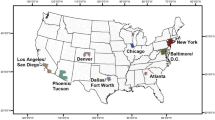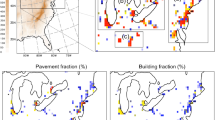Abstract
Two of several surface modification (heat-island reduction) strategies, increased surface albedo and urban reforestation, are evaluated via mesoscale meteorological and photochemical modelling of regulatory episodes in central and southern California. The simulations suggest that these strategies can have beneficial impacts on air quality, with increased albedo being relatively more effective than urban reforestation. The simulations also show that air quality indices, such as regional 1-h peaks, area peaks, 8-h relative reduction factors, 24-h averages, etc., improve for both central and southern California and that for the range of strategies evaluated here, the improvements in air quality can be significant. The simulations of southern California suggest that there may be a threshold beyond which further surface modifications tend to produce smaller net improvements in ozone air quality.
Similar content being viewed by others
References
Arya SP (1998) Introduction to micrometeorology. International Geophysics Series, vol 42. Academic Press, San Diego, 307 pp
Bloch L, Winer A (1994) Estimation of hydrocarbon emission from trees using phylogenetic relationships. In: Taha H et al. (eds) Ch. 9 in Analysis of Energy Efficiency and Air Quality in the SoCAB – Phase II. Lawrence Berkeley National Laboratory Report No. 35728, Berkeley, California
Benjamin MT, Sudol M, Bloch L, Winer AM (1996) Low-emitting urban forest: a taxonomic methodology for assigning isoprene and monoterpene emission rates. Atmos Environ 30: 1437–1452
Dudhia J (1993) A non-hydrostatic version of the Penn State/NCAR mesoscale model: validation tests and simulation of an Atlantic cyclone and cold front. Mon Wea Rev 121: 1493–1513
Emery C, Tai E, Yarwood G (2001) Enhanced meteorological modelling and performance evaluation for two Texas ozone episodes. Report prepared for the Texas Natural Resources Conservation Commission by Environ International Corp., Novato, California
Environ Corp (2004) Comprehensive Air Quality Model with Extensions Version 4. Environ Corp., Novato, California
EPA (1991) Guidelines for regulatory application of the Urban Airshed Model. U.S. Environmental Protection Agency Report EPA-450/4-91-013. Office of Air Quality Planning and Standards, RTP, North Carolina
EPA (1996) Air quality criteria for ozone and related photochemical oxidants. Report EPA-600-P93-004aF, US EPA ORD. National Center for Environmental Assessment, Washington, DC
Gery MW, Whitten GZ, Killus JP (1988) Development and testing of the CBM-IV for urban and regional modelling. Report EPA-600/3-88-012. U.S. EPA, Research Triangle Park, North Carolina
Grell GA, Dudhia J, Stauffer DR (1994) A description of the fifth generation PSU/NCAR mesoscale modelling system (MM5). Technical Note NCAR/TN—379+STR, National Center for Atmospheric Research, Boulder, Colorado
Guenther A, Baugh B, Brasseur G et al (1999) Isoprene emission estimates and uncertainties for the Central African EXPRESSO study domain. J Geophys Res 104: 30625–30639
Guenther AB, Fall R, Zimmerman PR et al (1993) Isoprene and monoterpene emission rate variability: model evaluations and sensitivity analyses. J Geophys Res 98: 12609–12617
Hong SH, Pan HL (1996) Nonlocal boundary layer vertical diffusion in a medium-range forecast model. Mon Wea Rev 124: 2322–2339
Kistler R, Kalnay E, Collins W et al (2001) The NCEP-NCAR 50-year reanalysis: monthly means CD-ROM and documentation. Bull Am Meteorol Soc 82: 247–267
Lehrman D, Knuth B, Fairley D (2001) Characterization of the CCOS 2000 measurement period. Interim Report (Contract 01-2CCOS) available from the California Air Resources Board, Sacramento, California
Levinson R, Berdahl PH, Akbari H (2005) Spectral solar optical properties of pigments, Part I: model for deriving scattering and absorption coefficients from transmittance and reflectance measurements. Solar Energy Mater Solar Cells. doi: 10.1016/j.solmat.2004.11.012
Mao Q, Gautney LL, Cook TM et al (2006) Numerical experiments on MM5-CMAQ sensitivity to various PBL schemes. Atmos Environ 40: 3092–3110
O’Brien JJ (1970) A note on the vertical structure of the eddy exchange coefficient in the planetary boundary layer. J Atmos Sci 27: 1213–1215
Pielke RA (1984) A three-dimensional numerical model of the sea breeze over South Florida. Mon Wea Rev 102: 115–139
Pielke RA (2002) Mesoscale Meteorological Modelling, International Geophysics Series, vol 78. Academic Press, San Diego, 676 pp
SCAQMD (2003) Air Quality Management Plan 2003. South Coast Air Quality Management District, Diamond Bar, California
Seaman NL, Stauffer DR (1996) SARMAP meteorological model. Final Report prepared for the San Joaquin Valleywide Air Pollution Study Agency, Department of Meteorology, Pennsylvania State University, University Park, PA
Seaman NL, Stauffer DR, Lario-Gibbs AM (1995) A multi-scale four dimensional data assimilation system applied in the San Joaquin Valley during SARMAP: Part I: modelling design and basic performance characteristics. J Appl Meteorol 34: 1739–1761
Steiner A, Tonse S, Cohen R, Goldstein A, Harley R (2006) Influence of future climate and emissions on regional air quality in California. J Geophys Res (Atmospheres) 111: D18303. doi: 10.1029/2005JD006935
Taha H (1996) Modelling the impacts of increased urban vegetation on the ozone air quality in the south coast air basin. Atmos Environ 30: 3423–3430
Taha H (1997) Modelling the impacts of large-scale albedo changes on ozone air quality in the south coast air basin. Atmos Environ 31: 1667–1676
Taha H (1999) Modifying a mesoscale meteorological model to better incorporate urban heat storage: a bulk-parameterization approach. J Appl Meteorol 38: 466–473
Taha H (2005) Surface modifications as a potential ozone air-quality improvement strategy in California: Part I: mesoscale modelling. Final report prepared for the California Energy Commission, Altostratus Inc. Available from the Energy’ Commission’s website at: http://www.energy.ca.gov/2005publications/CEC-500-2005-128/CEC-500-2005-128.PDF
Taha H (2007) Urban heat islands and their mitigation vs. local impacts of climate change. Presented at the 4th California Climate Change Conference, September 10–13 2007, Sacramento, California (available from author and from the California Energy Commission’s web site)
Taha H (2008) Episodic performance and sensitivity of the urbanized MM5 (uMM5) to perturbations in surface properties in Houston TX. Boundary-Layer Meteorol. doi: 10.1007/s10546-007-9258-6
Taha H, Chang SC, Akbari H (2000) Meteorological and air-quality impacts of heat island mitigation in three U.S. cities. Lawrence Berkeley National Laboratory Report No. 44222, Berkeley, California
Tesche TW, McNAlly DE, Emery CA et al (2001) Evaluation of the MM5 model over the Midwestern U.S. for three 8-hour oxidant episodes. Prepared for the Kansas City Ozone Technical Workgroup by Alpine Geophysics LLC and Environ International Corp
United States Geological Survey (1990) Cartographic projection procedures for the Unix Environment. USGS Report 90–284
Zhou L, Dickinson RE, Tian Y et al (2003) Comparison of seasonal and spatial variations of albedos from moderate-resolution imaging spectroradiometer (MODIS) and Common Land Model. J Geophys Res 108:D15 4488. doi: 10.1029/2002JD003326
Author information
Authors and Affiliations
Corresponding author
Rights and permissions
About this article
Cite this article
Taha, H. Urban Surface Modification as a Potential Ozone Air-quality Improvement Strategy in California: A Mesoscale Modelling Study. Boundary-Layer Meteorol 127, 219–239 (2008). https://doi.org/10.1007/s10546-007-9259-5
Received:
Accepted:
Published:
Issue Date:
DOI: https://doi.org/10.1007/s10546-007-9259-5




